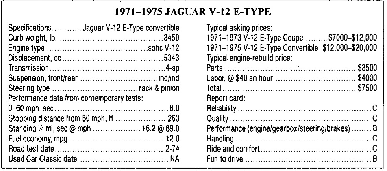 | 330 GT Registry |  |
1971-1975
Jaguar V-12
E-Type
Everyone on R&T’s staff professes to love old Jaguars. We agreed that we had to have a Jaguar in this year’s bargain
bests it was just a matter of which one. Because we weren’t trying to be practical this time, some staff members lobbied hard for the XK-120. We all know the tremendous impact that model had on the sports-car world when it was introduced at Earl’s Court in 1948. But there were other staff members who thought that early XJS models were good deals at $10,000 or $11,000, their current selling price, even if they do have questionable styling In the end, we compromised and selected the V-12 E-Type, as it’s a vintage Jaguar body with the modern 12-cylinder engine used in the XJS. But you have to wonder about our judgment if you review some of our original tests of the car. In our final evaluation of the V-12 E-Type, which came in a comparison test of five, high-price convertibles (February 1974), we were unkind: “understeers more than it should,” “the power steering is slow too light and without feel,” “there’s a torque-steer problem,” “ventilation inadequate,” “controls maddening,” etc.
The V-12 E-Type came in two versions, a coupe with two rear seats for legless adults and a convertible with a much more useful parcel space instead of the rear seats. Both were based on the long-wheel base 6-cylinder E-Type.
By the end of the Sixties, the redoubt able 6-cylinder engine used in the E-Type and sedans had lost its spunk, primarily because of ever-tougher U.S. emissions regulations. But it was still the age before expensive fuel and queuing at gas stations, so Jaguar developed a sophisticated all- aluminum V-12 unit. Unlike Jag’s classic dohc-6, the 12 has a single camshaft on each bank. It uses four Zenith-Stromberg carburetors and was among the first production cars to come with a transistorized ignition system. For 1971 and 1972, the V-12 had a modest 9.0:1 compression ratio, which was changed to an extremely low (for a sports car) 7.8:1 ratio in 1973. In all, it’s a very understressed engine.
Of course, there is a price to pay for all those cylinders. Fuel consumption is horrendous. And when you lift the bonnet of a V-12. you might reel back, staggered by the unveiled complexity. With pipes and hoses and wires and things enshrining the basic engine, it looks like an insane mechanic was turned loose on the poor thing. True, the engine is complicated and any major repair is going to be a big-bucks affair as it is on any exotic engine. But it’s also true that the engine is not particularly problem prone. with two exceptions. Naturally. Jaguar’s perennial problem, over heating, is one of them. Keeping the cooling system in top shape is important. which means flushing the coolant and re placing the hoses on a regular basis. And installing a manual override switch for the electric fans isn’t a bad idea either.
The other problem is with the electron ic ignition. The amplifier for the system is mounted in the cylinder bank valley. The amplifiers break down from the heat, and when they start to go bad, the driver notices a hesitation that feels like fuel starvation. They’re easy to replace, however.
The V-12 E-Type first went on sale in 1971, and the last was made in 1975. Be cause the coupe version was discontinued after 1973, there are more convertibles around. In fact, more V-12 E-Types were made in 1974 than in any other year (you can tell a 1974 model because they grew a pitiful pair of ugly rubber bumper over- riders in front). But the law of supply and demand aside, the more plentiful and romantic convertibles seem to be preferred by everyone, including R&T staffers. So prices for them are about double the prices for the coupes. In fact, V-12 coupes are real bargains right now.

ROAD & TRACK October 1985
Copyright 1985, CBS, Inc.
